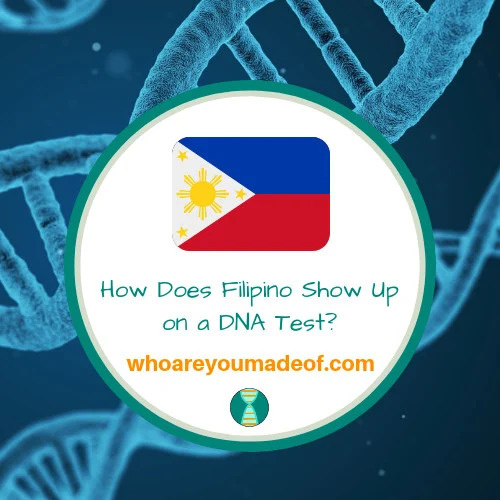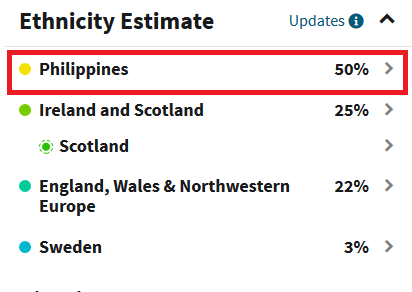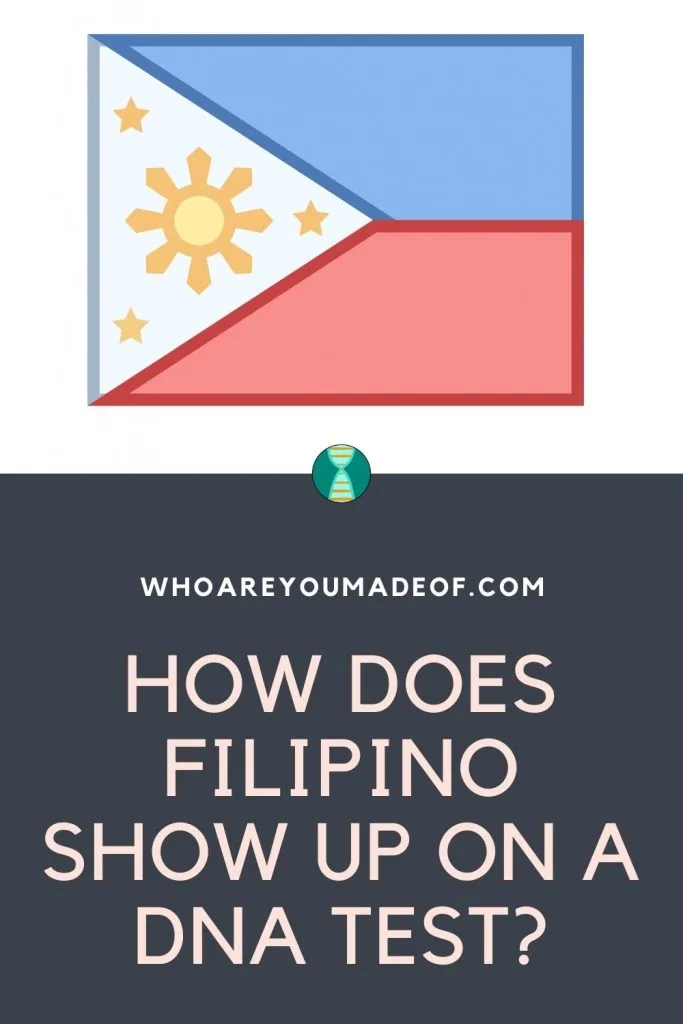Do you have Filipino ancestry? Are you thinking about taking a DNA test like the one offered by Ancestry DNA? If so, you might be wondering how Filipino would show up on a DNA test.
In this post, I'll explain what someone born in the Philippines or someone with Filipino roots could expect to see on their ethnicity results.

No matter if you are from the Philippines, or if one of your parents or grandparents was born there, you'll find out what to expect from a DNA test. I'll even show you sample results for someone whose parent was born in the Philippines.
DNA results have two parts: Ethnicity estimate and DNA matches
When you take a DNA test, you'll find that your DNA results contain two major parts. The first and most popular part is the ethnicity estimate, sometimes called an ancestry composition.
The second part is your amazing list of DNA matches. You can explore your Filipino heritage in both parts - I'll explain the basics here.
When most people ask how Filipino shows up on a DNA test, they are referring to their ethnicity estimate. It's the pretty pie chart that shows you which regions of the world your DNA matches, and it comes complete with a list of percentages.
Each DNA testing company reports Filipino ancestry slightly differently
The way in which your Filipino ancestry will show up on an autosomal DNA test will depend on the company that you choose to test with.
I generally recommend people test with Ancestry DNA to start, since you can easily download your results and upload them to other sites if you are interested in doing so.
Plus, Ancestry DNA is currently the only company that has the Philippines in its own DNA region. Even though I tend to focus on Ancestry, I'll let you know how Filipino roots might show up on the other big DNA testing company's results, too.
Which ethnicity region should people from the Philippines expect to see on a DNA test?
The main region that people from the Philippines would expect to see on a DNA test is from the Philippines. DNA from Southeast Asia is reported with slight differences among the four major DNA testing companies serving the US market:
- Ancestry DNA: "Philippines", a brand-new region that was recently added with the Ancestry September 2018 update.
- My Heritage DNA: "East Asia" broadly, with the possibility of showing "Filipino, Indonesian, and Malaysian" as a more detailed sub-region
- 23 and Me: "Southeast Asian" broadly, with the possibility of showing a more specific "Philippines" sub-region
- Family Tree DNA: "Southeast Asia"
Ancestry DNA only recently began to show the very specific "Philippines" region in ethnicity estimates. I'm glad that DNA testing companies are moving towards offering more detailed results, especially for people with non-European ancestry.
You might notice that some companies offer a more specific sub-region instead of a very general East Asia category. If you know much about geography, you'll know that East Asia covers a very, very big part of the world and encompasses billions of people.
In this sense, the ethnicity estimate is not super helpful, especially if you are interested in using your DNA test for genealogical purposes, and this is the precise reason that I recommend people focus on their DNA matches if they are interested in building an accurate family tree.
The companies that offer sub-regions are taking a big chance. If they offer a specific result, they run the risk of getting it wrong. By staying general (i.e. "East Asia"), companies have a better chance of reporting accurate results.
Most people will only be assigned a specific sub-region (assuming their DNA testing company tests for it) if they have a parent or a grandparent from the sub-region and similarity to the region can be detected in their DNA.
Are there other regions that might show up on a DNA test for someone with Filipino ancestry?
As you probably know, people from the Philippines lived under Spanish for more than 330 years. Following Spanish rule, the United States controlled the Philippines for about 45 years, and the Japanese ruled for a short period during World War II.
Each decade of interaction with these foreign powers brought the possibility of genetic admixing (a fancy genetic term for simply two populations "mixing").
This means that people who live in the Philippines could show any number of regions on a DNA test. The exact regions that you might find in your results will depend on your family's unique ancestry.
Example of Filipino Ancestry DNA results
The following is the ethnicity estimate of a person whose parent was born in the Philippines - it's a perfect 50%. The person's non-Filipino parent did a DNA test, and the ethnicity regions that we believe were inherited from the Filipino side of the family are shown within the red rectangles.
It would make sense that the person's Filipino parent was 100% Filipino - they were born there and all of their known ancestors were from the same country.

The DNA regions that are not highlighted are from the other side of the family.
Example of DNA results for a Filipino grandparent
Many people know that they have a Filipino grandparent, and might be curious to know whether this will show up on a DNA test. The person whose results are shown below is the child of the person whose results you saw in the previous image.
As you can see, this person shows 27% DNA from the Philippines. Another interesting observation is that the DNA test taker shares slightly more than the expected 25% with their Filipino grandparent - cool!

Conclusion
I hope that this post helped you get an idea of how your Filipino ancestry might show up on a DNA test. If you have done your DNA test, I hope that this post helped you understand a little bit more about what your results really mean.
Please feel free to post your results below to help other readers - everyone has a unique ancestry!
If you have any questions about something that you read in this post, I would encourage you to participate in the discussion below - I'm looking forward to hearing from you!
Thanks for stopping by today 🙂


Ian
Monday 17th of July 2023
My 3 year old daughter ended up with 49% Filipino 1% Portuguese from her mother's side of the family.
Tricia
Sunday 16th of July 2023
I just got my results back from Ancestry. My mom is Filipino and I wanted to know where that side came from because my family says we had Spanish and Chinese ancestry at some point. I’m upset because it didn’t break down anything at all like that, like where my ancestors may have came from. Is there a way to see this or is there another company that does this? It just says 50% Filipino.
Norman Lambot
Thursday 13th of July 2023
Ancestry is BS! Made me wait for so many weeks only to declare "100% Philippines" result - I imagined coz they knew my FB and it showed my hometown is in the Philippines. Furthermore, no explanation was attached to that result. It never answered all of my questions like why I don't look like a typical Filipino, why mine and my father's nosebridge are pretty high compared to most Filipinos, why my paternal grandma looked like she could pass as peruvian or chilean, why my paternal grandpa and some of his siblings looked somewhat European, why people in Europe and America would always assume I'm latino, etc. I'm glad I went for another test with a different company coz even if they don't know the questions in my mind, it's as if they were answering all those questions with the DNA result. I highly recommend CRIgenetics! Ancestry just took my money and gave me 2 words for a result: 100% Philippines.
Kit Kat
Friday 9th of December 2022
Ancestry is a pretty bad DNA test and a piece of rubbish.
karen
Thursday 25th of May 2023
@Kit Kat, hello thereI have a question trying to understand what is a dna region IT looks like I might have a little fillipino heritage on my ancestry region is that true what does that tell me about my ancestors did they come from there thanks karen nutkowitz